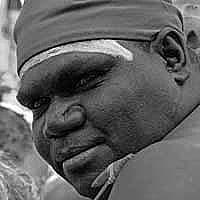Gunybi GANAMBARR

My thought is different from what they were thinking when the old people were painting. I try and bring the Yolgnu law (madayin) into reality. That is what is in my mind. To show what is already there.
My arts are according to the songs. It is what they are singing.
What is in the land and the law. It matches the songs. Right up to Gangan, Baraltja and Mungurru. It is painting on the songline.
In the last two decades, painting from Arnhem Land has undergone a pictorial transformation whereby the figurative elements that once dominated the nuwayak (bark paintings) and larrakitj (memorial poles) have receded into the background and in many cases have vanished altogether. The raw visual potency of miny’tji (sacred designs), which were previously covered to protect the uninitiated, is now being used by artists to demonstrate their considerable painterly skill and inscrutable cultural knowledge. Despite the seemingly undiluted nature of these sacred designs, sensitive information is incorporated into a system of codification and, as Howard Morphy writes, ‘the more knowledge one gains of the designs the less abstract they seem, yet the more the processes of abstraction become apparent’.[1]
Belonging to the Ngaymil clan, Gunybi Ganambarr was born in 1973 and primarily lives in his mother’s community at Gangan, which lies north-west of Blue Mud Bay in eastern Arnhem Land. Ganambarr has absorbed the minutiae and spirituality of place, and his paintings are poetic meditations on the specific tracts of land for which he is entitled to speak. His paintings recount the ancestral formation of the land, the beings that reside within its borders and the seasonal events that nourish its ecosystem. They also provide a basis for understanding the Yolngu worldview.
Ganambarr’s work is distinguished by its delicate crosshatching and compelling abstraction, but it is the incising and shaping of his barks that count among his most significant artistic innovations. The son-in-law of the artist, cultural activist and ceremonial leader Djambawa Marawili, Ganambarr is greatly indebted not only to Marawili, but also to preceding generations of Yolngu artists who have slowly loosened the strict possibilities of Yolngu visual matrices without divulging the innermost secrets the designs carry. Much of Ganambarr’s work is associated with seasonal renewal, but it is also reflective of a new dynamism of Arnhem Land bark painting and the way in which younger artists are retelling old stories in new and varied ways.
His Baraltja paintings are characteristic of his approach and technique. They are intricate nuwayak (bark paintings) that exploit the artist’s signature of shaping the bark to materially heighten the narrative. The paintings depict the lightning snake Burrut’tji (also known as Mundukul), who lives underneath the sacred waters of Baraltja, a mangrove creek. Burrut’tji lives in the mouth of Baraltja and appears periodically as a constantly shifting sandbar. The monsoonal rains of the wet season flush out the stagnant brackish water that has built up in Baraltja during the dry and pushes it towards the Gulf of Carpentaria. Sensing the mixing of fresh and salt water, Burrut’tji rises on his tail and spits lightning into the sky. Communicating with other ancestral lightning snakes to the north and the south, Burrut’tji illuminates the large offshore thunderhead clouds of the monsoon season. Alternating wavy lines of nuanced colour and delicate crosshatching bisect the paintings to evoke serpentine movement and the annual inundation of the floodplains that symbolically connect lands of the Dhuwa and Yirritja moieties.[2] The top third of the arch-shaped bark condenses the dramatic tension of this meteorological occurrence: radiating diamond motifs interrupt the looping lines that are emblematic of intermingling and coursing currents of water.
Division, balance and interconnectedness are fundamental principles of Yolngu philosophy and these qualities can also be discerned in Ganambarr’s meticulous work. As an artist and former park ranger (Environment Protection Officer), he unites his art practice and life to record cultural narratives and preserve environmental sites, teaching others about the importance of both. His paintings also celebrate the historic 2008 High Court of Australia decision that recognised exclusive Aboriginal rights to the intertidal zone of over 80 per cent of the Northern Territory’s coastline. But, most importantly, Ganambarr’s paintings represent modes of cultural knowledge that are organised around not what can be known but who can know it.
Stephen Gilchrist
[1]Howard Morphy, Abstractions, exhibition brochure, Drill Hall Gallery, The Australian National University, Canberra, 2003, p , viewed 6 February 2011, anu.edu.au/culture/abstractions/abstractions_brochure.pdf.
[2]A moiety is one of two intermarrying halves. In north-eastern Arnhem Land, for example, Yolngu people are divided into the two moieties of Yirritja and Dhuwa.




